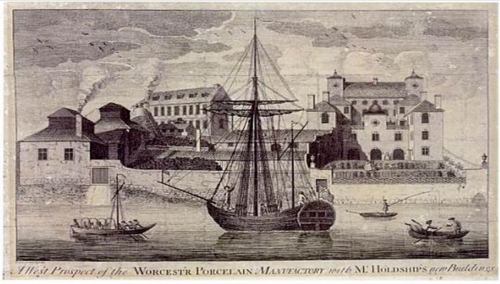 In 1751 a consortium of Worcester businessmen led by Dr. John Wall successfully purchased the porcelain company begun in Bristol in about 1749 by Benjamin Lund and William Miller. Having bought the going concern lock, stock, and barrel , they moved porcelain production to their own city and it was officially renamed the ‘Worcester Tonquin Manufacture’.
In 1751 a consortium of Worcester businessmen led by Dr. John Wall successfully purchased the porcelain company begun in Bristol in about 1749 by Benjamin Lund and William Miller. Having bought the going concern lock, stock, and barrel , they moved porcelain production to their own city and it was officially renamed the ‘Worcester Tonquin Manufacture’.
They produced an English soft-paste porcelain using soapstone as a substitute for china clay in the porcelain recipe, this created a workable material that fired well and produced fine quality wares including teawares that would withstand the thermal shock of boiling water. It was at this factory that both underglaze and overglaze printing on porcelain first became a commercially viable process. Underglaze blue printing was introduced sometime between 1754-56; overglaze printing began in the early 1750s and matured with the arrival of the master engraver Robert Hancock in the mid-1750s.[1]
Porcelain making at Worcester has a complex history, the original factory continuing under successive partnerships until about 1840, by which time there were two additional porcelain makers in the town. The Grainger family with various partners produced porcelain from 1801 to 1889 while Robert Chamberlain, who was trained at Dr. Wall’s factory, began a porcelain decorating business in about 1783 which within a few years was producing a hard-paste porcelain. During the first fifty years of the 19th century three separate factories were producing porcelain in Worcester,[2] two of them making the soapstone recipe into the 1840s but during the 1830s and 40s there was a gradual change to the standard bone china body developed in Staffordshire.[ii] In 1852 Kerr & Binns succeeded to the Chamberlain company and in 1862 the name of the business was changed to the Royal Worcester Porcelain Company.
Porcelain production continued in Worcester into the early years of the 21st century finally closing in 2009 when the Royal Worcester name was purchased by Portmeirion Potteries of-Stoke on-Trent .
[1]For more on Robert Hancock click here.
[2] For more on the Flight Barr & Barr partnerships click here
For more on the Worcester porcelain partnerships see http://www.worcesterporcelainmuseum.org.uk/factsheets/
